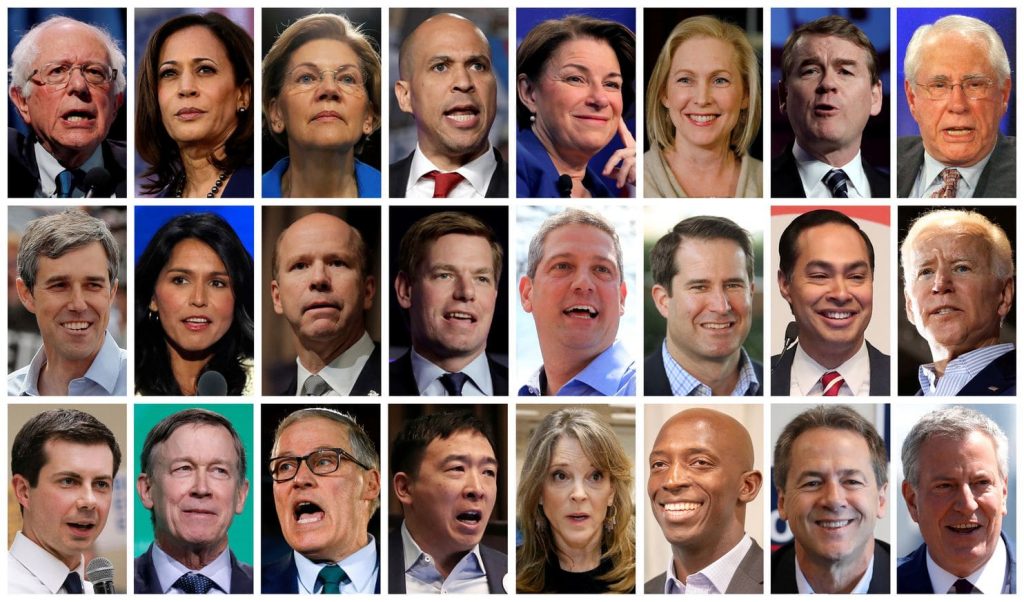Image Credits: Reuters.
As a political analyst who tries to make informed predictions about the future of American politics, I despaired when I realized that there would be 24 Democratic presidential candidates. It wasn’t just the unprecedented scenario that I found intimidating, although a lack of precedent certainly makes forecasting more like astrology than political science or sociology. The huge number of contestants introduced so many variables that I fretted there would be no way to anticipate how all the pieces would interact and influence each other.
Since I considered it a given that the race would demonstrate a high level of fluidity, my first approach was to look at who I considered to be in the strongest starting position. I quickly identified Joe Biden and Bernie Sanders as the two most likely to succeed candidates and wrote several pieces explaining why they each would be tough to dislodge from the top tier. Yet, I certainly did not think this would be the end of the story. I expected other candidates to catch fire for a time and then plateau in favor of a new flavor of the week or month. In other words, I predicted support for Biden and Sanders would be persistent and fairly stable, with a high floor. But around them, I expected a constant churn, with the real challenge to be getting fortuitous timing so a candidate surges right before the caucuses and primaries rather than in the relatively meaningless summer of 2019.
So far, I have only gotten half of that right. A look at trends in the Post and Courier-Change Research Poll of South Carolina demonstrates my point. There has been very little variation in the five survey results taken beginning in February. Biden began with a commanding lead and has led in all the polls by an “average of 22 percentage points.” He has lost only one point since the last poll, despite a few gaffes and controversies and less than stellar debate performances. The top six candidates in the poll have remained constant. Elizabeth Warren and Bernie Sanders have been in a tight race for second place, polling in the mid-to-high teens, with Kamala Harris slightly below them. Pete Buttigieg enjoyed a brief but modest bump that has dissipated, and he really represents the only significant fluctuation that has been seen. It’s almost as if nothing that has happened since February has had any real influence on the preferences of South Carolina voters, but they do seem to have changed what they prioritize as issues.
While Biden remained in control, voter preferences could change in the six months before South Carolina primary voters go to the polls on Feb. 29.
Consider voter priorities in the wake of recent mass shootings in Texas and Ohio. Gun rights replaced education as the second-most important issue for South Carolina Democratic primary voters in the latest poll. Health care remains the top issue.
What’s most remarkable in my opinion is the failure of lower tier candidates to catch fire. We’re not seeing much rotation or churn near the bottom, as most candidates are registering one percent or less in the results. I’m not sure what explains this, but it bolsters the legitimacy of my first instinct. I felt that Biden and Sanders would begin at the top of the polls and that they would remain there because they both enjoyed a solid and unshakable base of support. Whatever else seems to change, the size of their support seems almost immutable.
Yet, the desire within the Democratic Party to find a new generation of leadership is strong. Two old white career politicians aren’t the answer for many voters, and I expected more of a contest for third or fourth place. It seems that Warren and Harris have seized that territory and no one else can break through. Warren appears to be in the strongest position to supplant Sanders as the main alternative to Biden, and she’s polling ahead of him (by a single point) in South Carolina.
In the RealClearPolitics average of polls, both Warren and Harris have surged ahead of Sanders in Iowa, but Sanders maintains his hold on second place in New Hampshire and Nevada.
For anyone hoping that things will change in the next six months, the lack of movement over the last six months has to be sobering. Biden would be vulnerable if he faced only one significant rival, but facing three he is able to maintain a significant lead. He looks most vulnerable in New Hampshire and Iowa where his lead is in single digits.
In the past, there has been a lot of fluctuation in the polls in the months before the first contest in Iowa and often a lot of movement in the last couple of weeks. That could hold true again, but for now it does look like a four-way race despite there being two dozen people vying for the nomination.
